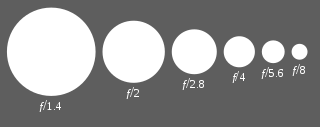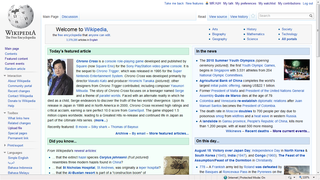
Widescreen images are images that are displayed within a set of aspect ratios used in film, television and computer screens. In film, a widescreen film is any film image with a width-to-height aspect ratio greater than the standard 1.37:1 Academy aspect ratio provided by 35mm film.

35 mm film (millimeter) is the film gauge most commonly used for motion pictures and chemical still photography. The name of the gauge refers to the width of the photographic film, which consists of strips 34.98 ± 0.03 mm (1.377 ± 0.001 inches) wide. The standard negative pulldown for movies is four perforations per frame along both edges, which results in 16 frames per foot of film. For still photography, the standard frame has eight perforations on each side.

A camera is an optical instrument to capture still images or to record moving images, which are stored in a physical medium such as in a digital system or on photographic film. A camera consists of a lens which focuses light from the scene, and a camera body which holds the image capture mechanism.

In photography, angle of view (AOV) describes the angular extent of a given scene that is imaged by a camera. It is used interchangeably with the more general term field of view.

A slide projector is an opto-mechanical device for showing photographic slides.

An overhead projector (OHP) is a variant of slide projector that is used to display images to an audience..
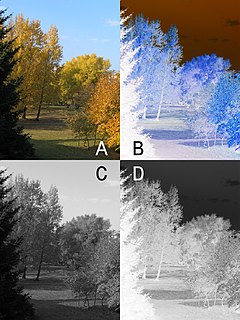
In photography, a negative is an image, usually on a strip or sheet of transparent plastic film, in which the lightest areas of the photographed subject appear darkest and the darkest areas appear lightest. This reversed order occurs because the extremely light-sensitive chemicals a camera film must use to capture an image quickly enough for ordinary picture-taking are darkened, rather than bleached, by exposure to light and subsequent photographic processing.

A movie projector is an opto-mechanical device for displaying motion picture film by projecting it onto a screen. Most of the optical and mechanical elements, except for the illumination and sound devices, are present in movie cameras.
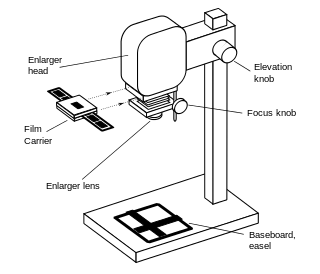
An enlarger is a specialized transparency projector used to produce photographic prints from film or glass negatives, or from transparencies.
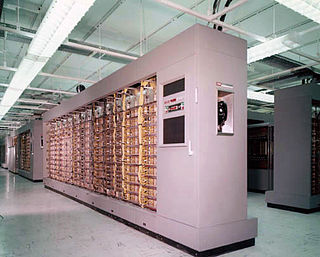
The AN/FSQ-7 Combat Direction Central, referred to as the Q7 for short, was a computerized command and control system for Cold War ground-controlled interception used in the USAF Semi-Automatic Ground Environment (SAGE) air defense network. The largest discrete computer system ever built, each of the 24 installed machines weighed 250 tons. The AN/FSQ-7 used a total of 60,000 vacuum tubes and up to 3 megawatts of electricity, performing about 75,000 instructions per second for networking regional radars.

Microforms are scaled-down reproductions of documents, typically either films or paper, made for the purposes of transmission, storage, reading, and printing. Microform images are commonly reduced to about one twenty-fifth of the original document size. For special purposes, greater optical reductions may be used.
A depth-of-field adapter is used to achieve shallow depth of field on a video camera whose fixed lens or interchangeable lens selection is limited or economically prohibitive at providing such effect. A DOF adapter could theoretically be used on a multitude of platforms, although it is most useful on prosumer digital camcorders where high resolution is a capability but the sensor size is still small enough to elicit use of the adapter. The term 35mm adapter is common, since most designs use a focusing screen the size of a 35mm film frame and interface with lenses designed for 35mm cameras. The use of adapters has decreased largely due to the video function available on newer DSLR cameras.

A planetarium projector is a device used to project images of celestial objects onto the dome in a planetarium.
Ultra Panavision 70 and MGM Camera 65 were, from 1957 to 1966, the marketing brands that identified motion pictures photographed with Panavision's anamorphic movie camera lenses. The 70 mm film gauge actually used 65 mm wide film in the camera to capture images in these processes. The projection print, however, was 70 mm film stock. The extra 5 mm on the positive projection print was used to accommodate six-track stereo sound. Ultra Panavision 70 and MGM Camera 65 were shot at 24 frames per second (fps) using anamorphic camera lenses. Ultra Panavision 70 and MGM Camera 65's anamorphic lenses compressed the image 1.25 times, yielding an extremely wide aspect ratio of 2.76:1.

A cue mark, also known as a cue dot, a cue blip, a changeover cue or simply a cue is a visual indicator used with motion picture film prints, usually placed on the right-hand upper corner of a frame of the film. Cue dots are also used as a visual form of signalling on television broadcasts.

Talaria was the brand name of a large-venue video projector from General Electric introduced in 1983.
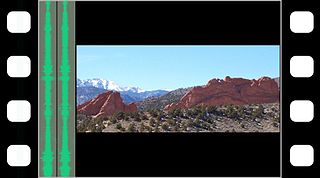
Anamorphic format is the cinematography technique of shooting a widescreen picture on standard 35mm film or other visual recording media with a non-widescreen native aspect ratio. It also refers to the projection format in which a distorted image is "stretched" by an anamorphic projection lens to recreate the original aspect ratio on the viewing screen. The word anamorphic and its derivatives stem from the Greek words meaning "formed again". As a camera format, anamorphic format is losing popularity in comparison to "flat" formats such as Super 35 mm film shot using spherical lenses; however, because most film movie projectors use anamorphic projection format, spherical format negatives are commonly converted into anamorphic prints for projection.
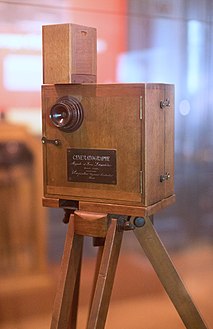
The history of film technology traces the development of film technology from the initial development of "moving pictures" at the end of 19th century to the present time. Motion pictures were initially exhibited as a fairground novelty and developed into one of the most important tools of communication and entertainment in the 20th century. Major developments in motion picture technology have included the adoption of synchronized motion picture sound, color motion picture film, and the adoption of digital film technologies to replace physical film stock at both ends of the production chain by digital image sensors and projectors.




